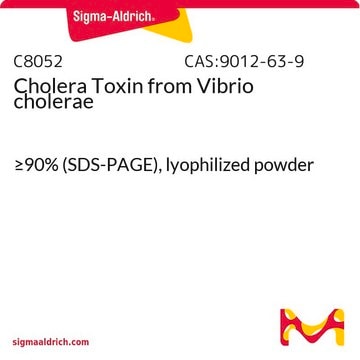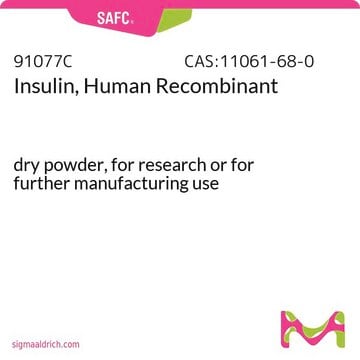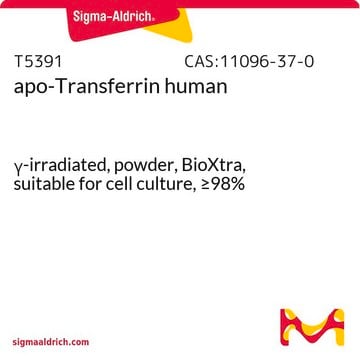Insulin has low solubility at neutral pH. It can be solubilized at 1-10 mg/mL in dilute acetic (1%) or hydrochloric acid, pH 2-3. Insulin can also be solubilized in 125 mM NaHCO3.15 However, alkaline stock solutions are not recommended since high pH increases the rate of deamidation and aggregation.
I1882
Insuline from bovine pancreas
γ-irradiated, BioXtra, suitable for cell culture, potency: ≥20 units/mg (USP units), lyophilized powder
Synonyme(s) :
Bovine insulin, Cell culture grade insulin
Sélectionner une taille de conditionnement
Sélectionner une taille de conditionnement
About This Item
Produits recommandés
Niveau de qualité
Stérilité
γ-irradiated
Gamme de produits
BioXtra
Forme
lyophilized powder
Puissance
≥20 units/mg (USP units)
Technique(s)
cell culture | mammalian: suitable
Solubilité
acetic acid: 2 mg/mL (pH: 2-3)
hydrochloric acid: 2 mg/mL (pH: 2-3)
Numéro d'accès UniProt
Conditions d'expédition
ambient
Température de stockage
−20°C
Clé InChI
IXIBAKNTJSCKJM-BUBXBXGNSA-N
Informations sur le gène
bovine ... INS(280829)
Vous recherchez des produits similaires ? Visite Guide de comparaison des produits
Application
Actions biochimiques/physiologiques
Autres remarques
Forme physique
Reconstitution
Produit(s) apparenté(s)
Code de la classe de stockage
11 - Combustible Solids
Classe de danger pour l'eau (WGK)
WGK 3
Point d'éclair (°F)
Not applicable
Point d'éclair (°C)
Not applicable
Équipement de protection individuelle
Eyeshields, Gloves, type N95 (US)
Faites votre choix parmi les versions les plus récentes :
Déjà en possession de ce produit ?
Retrouvez la documentation relative aux produits que vous avez récemment achetés dans la Bibliothèque de documents.
Les clients ont également consulté
-
how to soluble i1882? What percent dilution should I use to gial acetic acid?
1 answer-
Helpful?
-
-
What can be used to make a solution of insulin?
1 answer-
Insulin is soluble in dilute acids and alkalis. The solubility of insulin is tested at 2 mg/mL in water (acidified to pH 2 with hydrochloric acid). One can also use 1 mL of water acidified to pH 2 with 10 μL of glacial acetic acid to dissolve 2 mg of insulin. A 10 mg/mL solution of bovine insulin in 25 mM HEPES at pH 8.2 is offered as Product No. I0516.
Helpful?
-
-
How can I store the insulin solution? How long?
1 answer-
The USP recommends that solutions of insulin be stored at 2-8°C. It is not recommended to freeze solutions of insulin, as it can aggregate. Sterile solutions should be stable for at least 1 year at 2-8°C.
Helpful?
-
-
How many units of insulin are present in one vial of Product I1882, Insulin from bovine pancreas?
1 answer-
Product No. I1882 has a potency specification of not less than 2520 USP units per vial. For a vial that contains (nominally) 100 mg, that works out to 25.2 USP units/mg. The potency in terms of units per vial can be found the on lot-specific Certificate of Analysis.
Helpful?
-
-
What is the comparison between International Units (IU) and USP units for insulin?
1 answer-
The international unit (IU) of insulin is based on the International Standard Preparation of Bioassay (1958). The standard preparation is a mixture of 52% bovine and 48% porcine insulin, containing 24 units/mg. Reference: Martindale: The Extra Pharmacopoeia, 29th ed., p. 392. High purity bovine pancreatic insulin typically assays at approximately 27 USP units per mg. So the IU and USP unit are not identical, but they are approximately 1:1.
Helpful?
-
-
What is the Department of Transportation shipping information for this product?
1 answer-
Transportation information can be found in Section 14 of the product's (M)SDS.To access the shipping information for this material, use the link on the product detail page for the product.
Helpful?
-
-
What is the amino acid sequence for Product I1882, Insulin from bovine pancreas?
1 answer-
The sequence and structure of insulin can be found on the product information sheet (under Documents, above).
Helpful?
-
Active Filters
Notre équipe de scientifiques dispose d'une expérience dans tous les secteurs de la recherche, notamment en sciences de la vie, science des matériaux, synthèse chimique, chromatographie, analyse et dans de nombreux autres domaines..
Contacter notre Service technique












